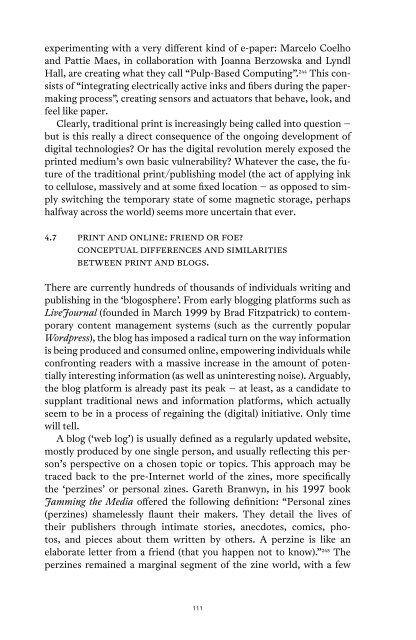Post- Digital Print - Monoskop
Post- Digital Print - Monoskop
Post- Digital Print - Monoskop
You also want an ePaper? Increase the reach of your titles
YUMPU automatically turns print PDFs into web optimized ePapers that Google loves.
experimenting with a very different kind of e-paper: Marcelo Coelho<br />
and Pattie Maes, in collaboration with Joanna Berzowska and Lyndl<br />
Hall, are creating what they call “Pulp-Based Computing”. 244 This consists<br />
of “integrating electrically active inks and fibers during the papermaking<br />
process”, creating sensors and actuators that behave, look, and<br />
feel like paper.<br />
Clearly, traditional print is increasingly being called into question –<br />
but is this really a direct consequence of the ongoing development of<br />
digital technologies? Or has the digital revolution merely exposed the<br />
printed medium’s own basic vulnerability? Whatever the case, the future<br />
of the traditional print/publishing model (the act of applying ink<br />
to cellulose, massively and at some fixed location – as opposed to simply<br />
switching the temporary state of some magnetic storage, perhaps<br />
halfway across the world) seems more uncertain that ever.<br />
4.7 print and online: friend or foe?<br />
conceptual differences and similarities<br />
between print and blogs.<br />
There are currently hundreds of thousands of individuals writing and<br />
publishing in the ‘blogosphere’. From early blogging platforms such as<br />
LiveJournal (founded in March 1999 by Brad Fitzpatrick) to contemporary<br />
content management systems (such as the currently popular<br />
Wordpress), the blog has imposed a radical turn on the way information<br />
is being produced and consumed online, empowering individuals while<br />
confronting readers with a massive increase in the amount of potentially<br />
interesting information (as well as uninteresting noise). Arguably,<br />
the blog platform is already past its peak – at least, as a candidate to<br />
supplant traditional news and information platforms, which actually<br />
seem to be in a process of regaining the (digital) initiative. Only time<br />
will tell.<br />
A blog (‘web log’) is usually defined as a regularly updated website,<br />
mostly produced by one single person, and usually reflecting this person’s<br />
perspective on a chosen topic or topics. This approach may be<br />
traced back to the pre-Internet world of the zines, more specifically<br />
the ‘perzines’ or personal zines. Gareth Branwyn, in his 1997 book<br />
Jamming the Media offered the following definition: “Personal zines<br />
(perzines) shamelessly flaunt their makers. They detail the lives of<br />
their publishers through intimate stories, anecdotes, comics, photos,<br />
and pieces about them written by others. A perzine is like an<br />
elaborate letter from a friend (that you happen not to know).” 245 The<br />
perzines remained a marginal segment of the zine world, with a few<br />
111

















